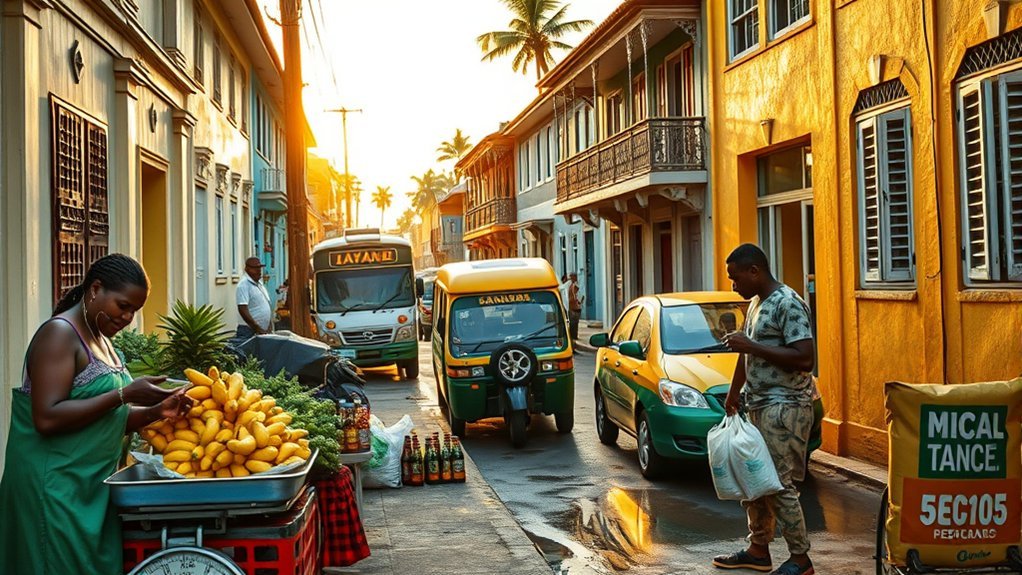You’ll typically need about $2,500–$3,000 a month to support a modest middle‑class family of four in Guyana, roughly half to two‑thirds the cost of a similar U.S. lifestyle. Rent and groceries are far cheaper, utilities and internet run lower, and public transport and healthcare visits cost a fraction of U.S. rates, though mortgages and some imported goods are pricier. Costs vary by city and choices, and below you’ll find detailed breakdowns to help plan your move.
Overview of Living Costs in Guyana (2025)
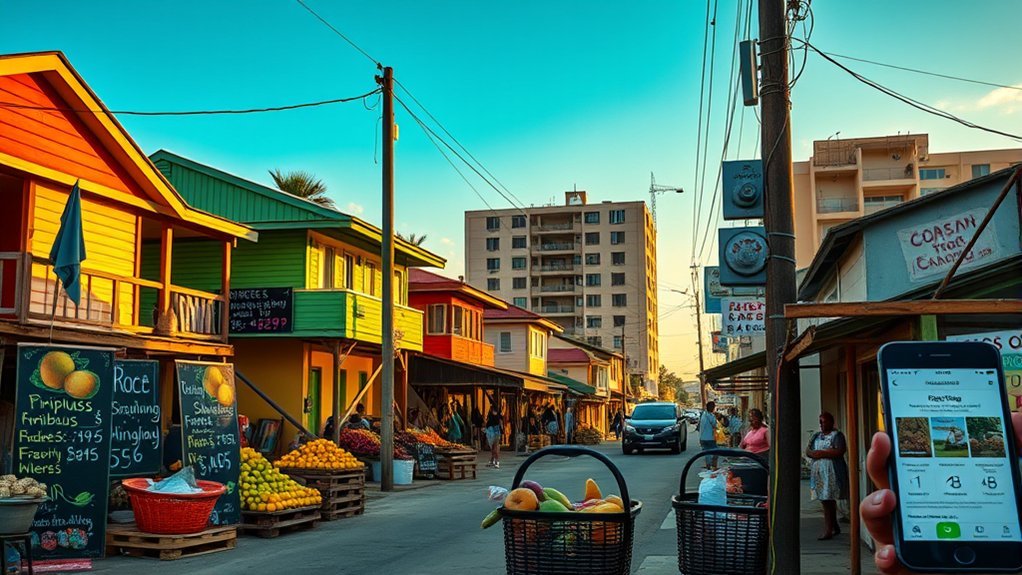
Although daily expenses vary by location, a family of four in Guyana can expect monthly costs around $2,500–$3,000 USD, substantially lower than typical U.S. expenses.
You’ll find the overall cost of living noticeably reduced: utilities average about $73.8 versus $190 in the U.S., and local transport runs roughly $36.1 monthly compared to $69.3. Eating out is also cheaper — a dinner for two costs about $28.6 versus $78.2.
These comparisons show you won’t need as much money to maintain a similar lifestyle as in the U.S. Data-driven contrasts make budgeting straightforward: combined savings on utilities, transport, and dining drive much of the gap in living expenses.
You’ll need less money to maintain a similar U.S.-style lifestyle — savings on utilities, transport and dining add up.
While rent is noted to be lower by about 62.5% compared to U.S. levels, rising local housing costs may affect future budgets. For now, Guyana presents a clear comparative advantage in everyday spending.
Housing and Rental Market Trends
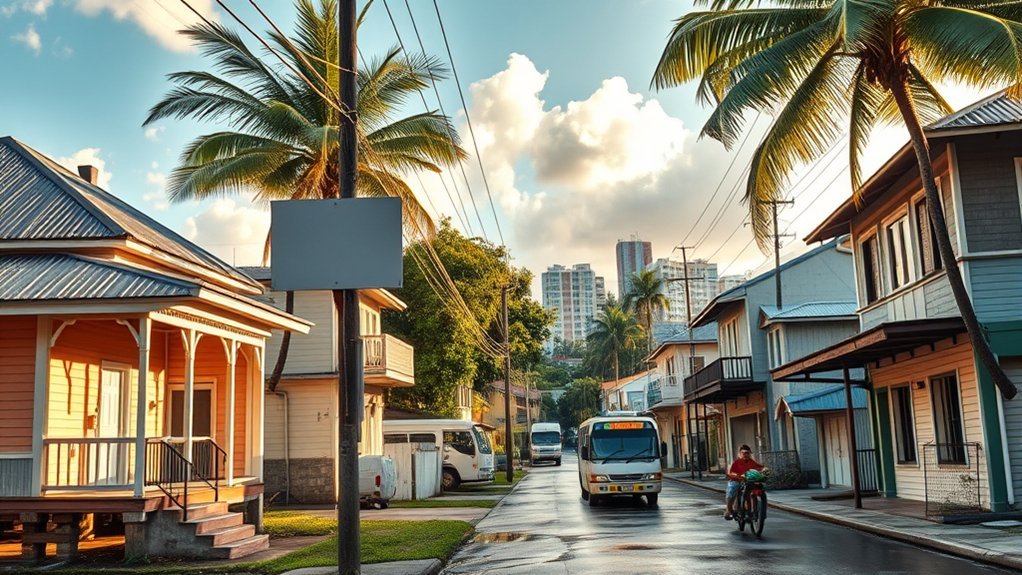
When you compare housing costs, Guyana still looks cheaper overall—even with rising local prices—since average rents run about 62.5% below U.S. levels; however, urban apartment prices tell a more nuanced story at roughly $3,449 per square metre in city centres versus $1,308 per square metre in the suburbs.
Currency depreciation plus a 7.45% 20-year mortgage rate (vs. 6.42% in the U.S.) are driving up ownership costs and narrowing the affordability gap.
You’ll find these core trends if you’re evaluating living in Guyana:
- Rent advantage: average rents ~62.5% lower than U.S., favoring tenants and short-term movers.
- Urban premium: city-centre apartments cost ~2.6x suburban per sqm, raising urban living expenses.
- Ownership pressure: GDY depreciation and 7.45% mortgages increase monthly payments and total financing costs.
- Comparative outcome: rentals remain attractive, but long-term affordability for buyers is eroding, so factor exchange-rate and interest-rate risk into housing decisions.
Monthly Budget for a Family of Four
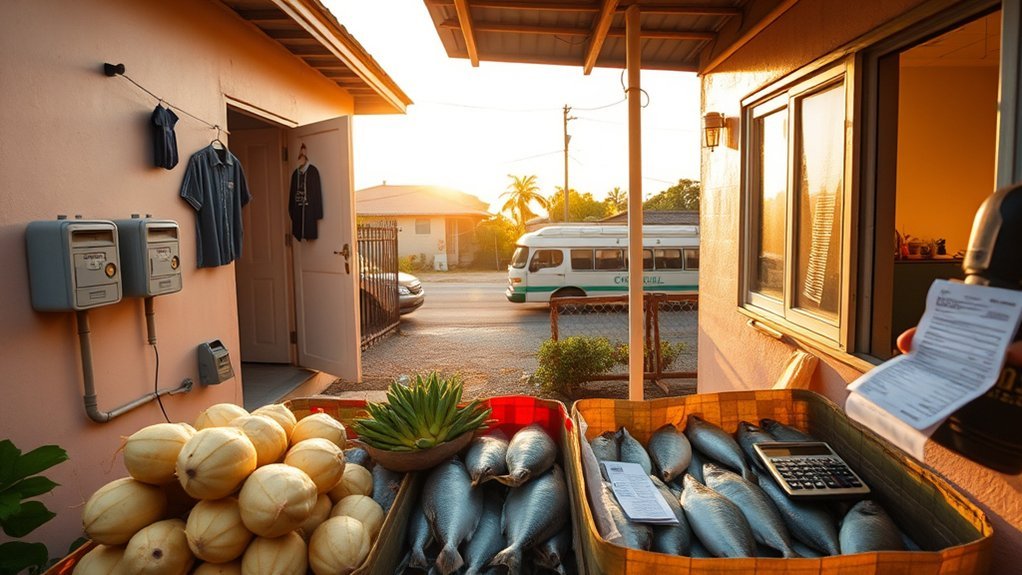
For a family of four in Guyana you can expect total monthly costs around $2,500–$3,000 USD, noticeably lower than typical U.S. budgets.
Housing and utilities drive much of the gap — rent-related costs are about 62.5% cheaper and utility bills average roughly $73.80 versus $190 in the U.S.
Food and groceries are also more affordable (milk ≈ $2.72/L) and local transport is cheaper, which helps keep the overall budget down.
Estimated Monthly Expenses
If you’re budgeting for a family of four in Guyana, expect monthly expenses of roughly $2,500–$3,000 (GYD 525,000–630,000), driven primarily by housing and everyday essentials.
You’ll use cost comparison and budget tips for effective financial planning: housing is much cheaper than the U.S. (rent ~62.5% lower) but rising, so prioritize stability.
- Utilities: average ~$73.80/month, well below the U.S. ~$190 — adjust usage to save.
- Transportation: single ticket ~$0.57; monthly pass ~$36.10 — public transit is economical.
- Groceries: milk ~$2.72/L, bread ~$1.63/0.5kg — staple prices influence total food spend.
- Contingency: allocate 10–15% for price variability and unexpected costs.
Housing and Utilities
Although housing costs in Guyana run about 62.5% lower than in the U.S., you’ll still want to budget carefully: a family of four can expect combined monthly housing and utilities of roughly $1,500–$2,000, driven by rent or mortgage payments and ~$73.80 in utility bills, compared with about $190 in U.S. utilities.
City-center rents average ~$3,449 per m² versus $4,576 in the U.S., and mortgage rates average 7.45% over 20 years (vs. 6.42% in the U.S.), so prioritize location and tenure to optimize monthly cash flow.
You’ll compare housing styles—apartments, semi-detached, single-family—and review rental agreements closely. Expect to choose among utility providers for electricity, water and internet; negotiate clauses to control long-term costs and confirm inclusions before signing.
Food and Groceries
A monthly grocery budget for a family of four in Guyana will typically run about $600–$800 USD, driven largely by a mix of affordable local produce and pricier imported items.
You’ll notice staple prices—milk (1L) ~$2.72, bread (0.5 kg) ~$1.63—keep basics cheap, while imported goods push costs up.
Use local market benefits to source fruits and vegetables, which are usually the most budget-friendly.
Compare eating out: lunch ~$5.45 per person, dinner for two ~$28.60, to decide when cooking saves money.
Apply these grocery shopping tips and budget meal ideas to stretch your monthly allotment.
- Shop markets for produce.
- Buy staples in bulk.
- Limit imported items.
- Mix home-cooked and occasional dining.
Grocery and Food Price Breakdown

You’ll find local staples like milk at about $2.72 per liter and bread (0.5 kg) at $1.63, with eggs around $2.14 per dozen — cheaper than U.S. eggs but milk costs significantly more than the U.S. $1.10.
Eating out is generally cheaper too: a McDonald’s meal runs ~$7.30 and a dinner for two averages $28.60 versus $11.20 and $78.20 in the U.S., respectively.
These contrasts reflect a clear import-versus-local split, where locally produced staples and restaurant meals tend to lower grocery bills while imported items drive prices up.
Local Staple Prices
Compare key grocery items and you’ll see that local staples in Guyana are generally cheaper than in the U.S.: you’ll notice local food trends shaped by market accessibility and cultural influences that lower many staple costs.
Be data-driven when comparing.
- Milk: Guyana $2.72/L vs U.S. $1.10/L — milk is an outlier, more expensive locally.
- Bread (0.5 kg): Guyana $1.63 vs U.S. $3.59 — basic carbs are cheaper in Guyana.
- Fast food meal: Guyana $7.30 vs U.S. $11.20 — convenience foods remain cost-competitive.
- Restaurant meal for two: Guyana $28.60 vs U.S. $78.20 — dining out is substantially less.
You can expect grocery essentials overall to favor local prices, reflecting supply chains and consumer habits.
Eating Out Costs
How much can you save eating out in Guyana? You’ll pay about $5.45 for a typical lunch—far below the U.S. $19.30 average—so daily midday meals cut costs dramatically.
Dinner for two averages $28.60 versus $78.20 in the U.S., reflecting cheaper restaurant types from modest diners to mid-range tables.
Fast food runs about $7.30 compared with $11.20 back in the U.S., and a 0.5L beer is roughly $2.11 versus $6.20.
Cappuccinos cost $4.08 against $5.25, indicating lower café expenses.
These numbers show you can follow local cuisine and modern food trends without high spend. Choose casual eateries and emerging food-trend spots to maximize savings while sampling diverse offerings.
Import Vs Local
After seeing how much you can save eating out, it’s worth looking at groceries to stretch your budget further: locally produced staples usually cost less than imports.
You’ll find a clear price comparison between local food and imported goods when planning meals. Use local markets for seasonal fruits, vegetables, and bread to lower costs.
- Milk (1L) — imported ~$2.72; local alternatives often cheaper or variable by season.
- Bread (0.5 kg) — about $1.63, a reliable, affordable staple.
- Vegetables/fruits — lower due to reduced transport; prices fluctuate with harvests.
- Fast food vs imported brands — meals average $7.30; imported-brand items carry a premium.
Choose local food where possible to reduce expenses and exposure to import price volatility.
Dining Out and Entertainment Expenses
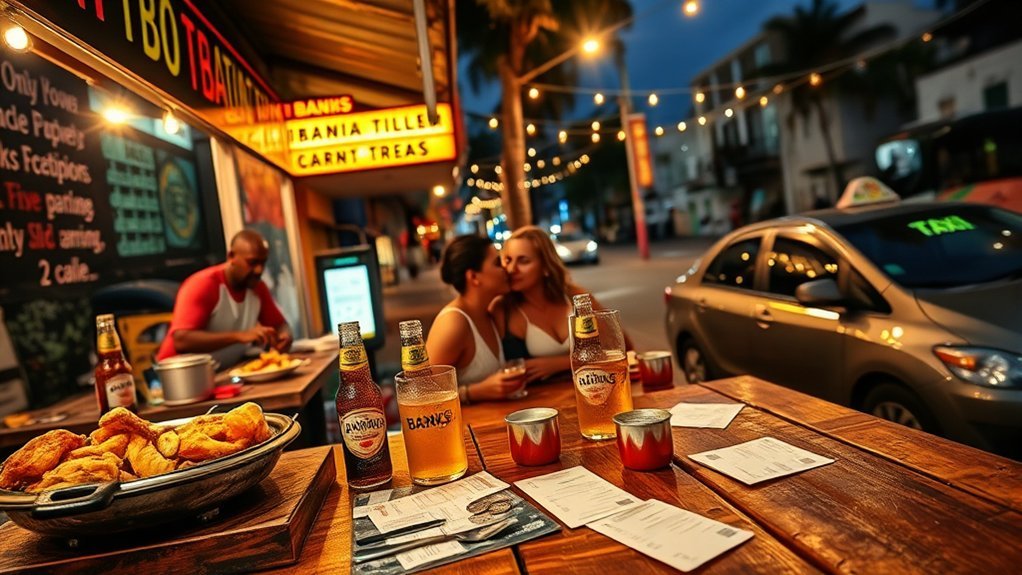
Dining out in Guyana is noticeably cheaper than in the U.S.: a typical lunch runs about $5.45 versus $19.30, a restaurant meal for two averages $28.60 compared with $78.20, and common items like a McDonald’s combo ($7.30), a 0.5L pub beer ($2.11), and a cappuccino ($4.08) all undercut U.S. prices, reflecting roughly one-third to two-thirds of American costs depending on the item.
You’ll find that lower prices let you sample cultural dining experiences more often—street food, seaside cookouts, and Creole-influenced menus cost less per visit than similar U.S. outings. Local cuisine specialties, like pepperpot and cook-up rice, are affordable and widely available, so you can eat well without stretching your budget.
When you dine, follow simple restaurant etiquette tips: dress smart-casual for sit-down places, greet staff politely, and tip modestly where service is good.
Utilities, Internet, and Household Services
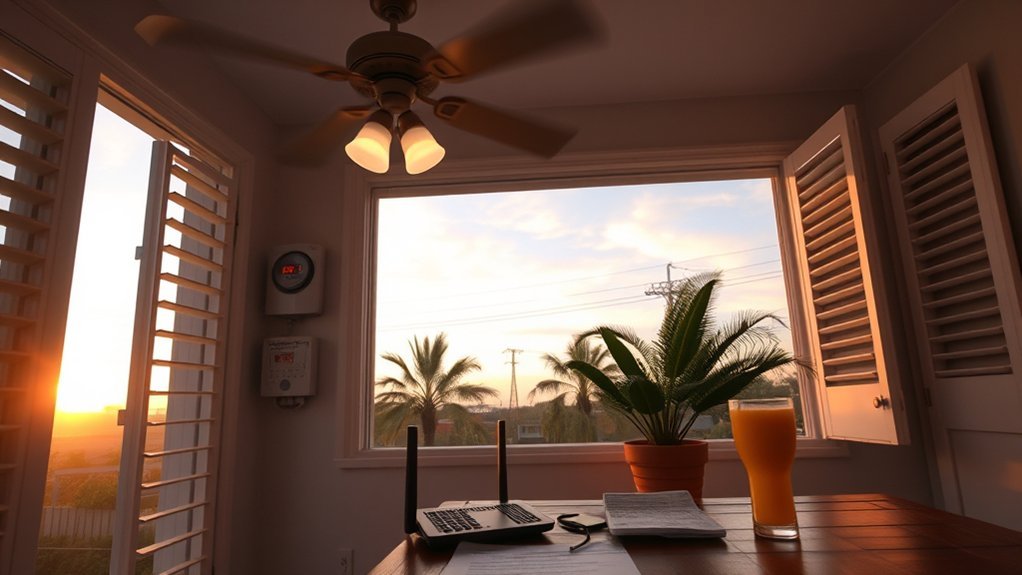
While utilities in Guyana cost noticeably less than in the U.S., you’ll still see trade-offs: an average family pays about $73.80 monthly for electricity, water, heating/cooling and garbage—roughly 61% cheaper than the U.S. average of $190—while a 50 Mbps+ unlimited internet plan runs about $47.40 versus $66.50 in the U.S.; however, mortgage interest averages 7.45% over 20 years compared with 6.42% in the U.S., and household services like cleaning and maintenance tend to be more affordable, reflecting the country’s lower everyday service costs.
You’ll want targeted utility management strategies to maximize savings: conserve electricity, monitor water use, and schedule maintenance to prevent costly repairs.
Evaluate internet provider options for speed and reliability; lower prices don’t always mean better uptime.
Household service availability is good in urban areas, with competitive rates for cleaning and repairs.
Compare providers, read contracts for fees, and factor higher mortgage rates into long-term housing costs when planning your budget.
- Monthly utilities: $73.80
- Internet (50+ Mbps): $47.40
- U.S. comparisons: $190 / $66.50
- Mortgage rate (20 yrs): 7.45%
Transportation and Commuting Costs
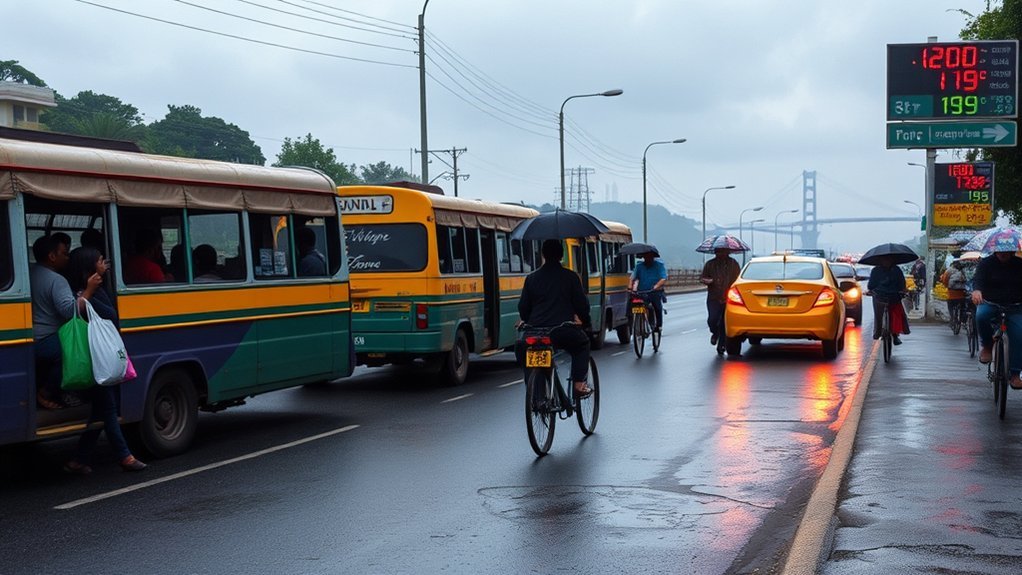
You’ll find public transport in Guyana is particularly cheap: a single local ticket costs about $0.57 versus $2.35 in the U.S., and a monthly pass runs roughly $36.10 compared to $69.30.
If you prefer taxis or owning a car, note an 8 km taxi ride averages $21.70—slightly above the U.S. $18.50—so private vehicle expenses can narrow the gap.
Public Transport Fares
One local bus ticket in Guyana costs about $0.57—roughly a quarter of the $2.35 U.S. average—so if you commute daily you’ll see clear savings; monthly passes follow the same pattern at about $36.10 versus $69.30 in the U.S., making regular public transit substantially cheaper, even though an 8 km taxi runs about $21.70 in Guyana compared with $18.50 in the U.S.
You’ll find public transit affordable and practical for routine trips; fare comparison shows clear urban savings but taxis remain relatively pricey.
Consider these points for riding experiences and budgeting:
- Local single fare: $0.57 (Guyana) vs $2.35 (U.S.)
- Monthly pass: $36.10 vs $69.30
- 8 km taxi: $21.70 vs $18.50
- Daily commute: lower overall transit expenditure in Guyana
Private Vehicle Expenses
If public transit looks cheaper for regular trips, compare that with the full costs of owning a car in Guyana: fuel tends to be cheaper than in the U.S., which can lower your per-kilometer expense, but higher local taxi fares for short rides suggest private vehicle use still plays a major role in urban pricing dynamics.
You’ll save versus U.S. transit ticket rates ($0.57 vs $2.35 per ride; monthly $36.10 vs $69.30), yet taxis cost about $21.70 for 8 km—higher than the U.S. $18.50—making occasional car use competitive.
Factor fuel efficiency when estimating fuel spend. Add vehicle insurance and variable maintenance costs driven by parts availability.
Follow maintenance tips: schedule regular servicing, source reliable parts, and compare insurers to control total ownership cost.
Healthcare and Insurance Pricing

Healthcare costs in Guyana are markedly lower than in the U.S.: a typical doctor’s visit runs about $22 versus roughly $121 in America, basic insurance plans cost $20–$50 per month, and many prescriptions go for less than half the U.S. price.
You’ll find better healthcare accessibility in urban centers, though rural access can be limited; many expats choose private insurance options to secure faster service at private medical facilities.
Be pragmatic: public care is available but often slower and less equipped.
- Doctor visit: ~$22 (vs. $121 U.S.) — clear cost advantage.
- Basic insurance: $20–$50/month — covers essential outpatient care.
- Prescriptions: typically <50% of U.S. prices — lowers ongoing costs.
- Emergencies: private hospital bills can be high and variable — plan for out-of-pocket exposure.
You should weigh premiums against likely usage; if you value speed and equipment, budget for private insurance and potential emergency expenses.
Education and Schooling Costs

Education costs in Guyana vary widely: public primary and secondary schooling is free, while private schools charge roughly 1,000–5,000 GYD per month, and many families pay extra for perceived higher-quality or international curricula.
You’ll weigh public vs private options: public schools have no tuition but may lack some educational resources, while private institutions often provide smaller classes, extracurriculars and international syllabi at a clear premium.
For higher education, the University of Guyana charges about 60,000–200,000 GYD yearly depending on the program, so you should budget accordingly.
Don’t forget ancillary expenses—uniforms, books and transport typically add 20,000–50,000 GYD annually per child.
When evaluating tuition affordability, compare total annual costs (tuition plus extras) against your household budget.
Government investment in schooling infrastructure is increasing, which could narrow resource gaps and influence long-term costs, but currently private schooling remains the primary route if you prioritize perceived quality and broader educational resources.
Salary Adjustment and Relocation Planning

Because your U.S. salary won’t translate directly, use a salary-adjustment calculator to estimate the income you’d need to preserve purchasing power in Guyana, where overall living costs run about 32.2% lower and rent averages 62.5% below U.S. levels.
For a family of four, budget roughly $2,500–$3,000 per month while factoring local salaries, currency depreciation, and volatile economic conditions into your target compensation. You’ll plan relocation expenses and set realistic salary expectations by comparing net pay, taxation, and benefits.
- Estimate required gross income using an income comparison tool and adjust for Guyana dollar risk.
- Tally relocation expenses: flights, shipping, temporary housing, and visa fees.
- Compare local salary ranges for your role versus adjusted U.S. equivalents to spot gaps.
- Build a 6–12 month buffer for inflation, currency swings, and unexpected costs.
Use this data-driven approach to negotiate compensation that preserves living standards without overcommitting financially.
Frequently Asked Questions
Can a US Citizen Move to Guyana?
Yes — you can move to Guyana, but you’ll need to meet visa requirements, assess employment opportunities versus U.S. wages, and plan cultural adaptation; comparative cost advantages exist, so prioritize permits, jobs, and local networking.
How Much Does the Average Person Make in Guyana?
Like a steady drumbeat, you earn about GYD 80,000 (~USD 400) monthly; average income levels vary, employment opportunities differ by sector, and salary comparisons show oil/gas pay much higher than agriculture or retail.
Is Guyana a Good Place to Retire?
Yes — you’ll find Guyana attractive for retirement: retirement benefits stretch further, healthcare options are far cheaper, and lifestyle considerations favor affordable living and tight expat communities, though infrastructure and services remain more limited than in the U.S.
What Is the Average Cost to Build a House in Guyana?
You’ll typically pay about $80–$150 per sq ft (roughly $30k–$50k for a modest three‑bedroom). Construction materials prices, labor costs analysis, and housing market trends show urban land and permits can raise totals considerably.
Conclusion
In 2025, you’ll find Guyana affordable compared with regional peers: monthly costs for a family of four typically run lower than Trinidad and Tobago but above rural Suriname. Housing and food remain your biggest variables; expect to spend most of your budget there. Healthcare and international schooling add premium spikes. Plan salaries and relocations using local price indices and a buffer of 10–20%—it keeps you from being caught with your pants down when surprises arise.

